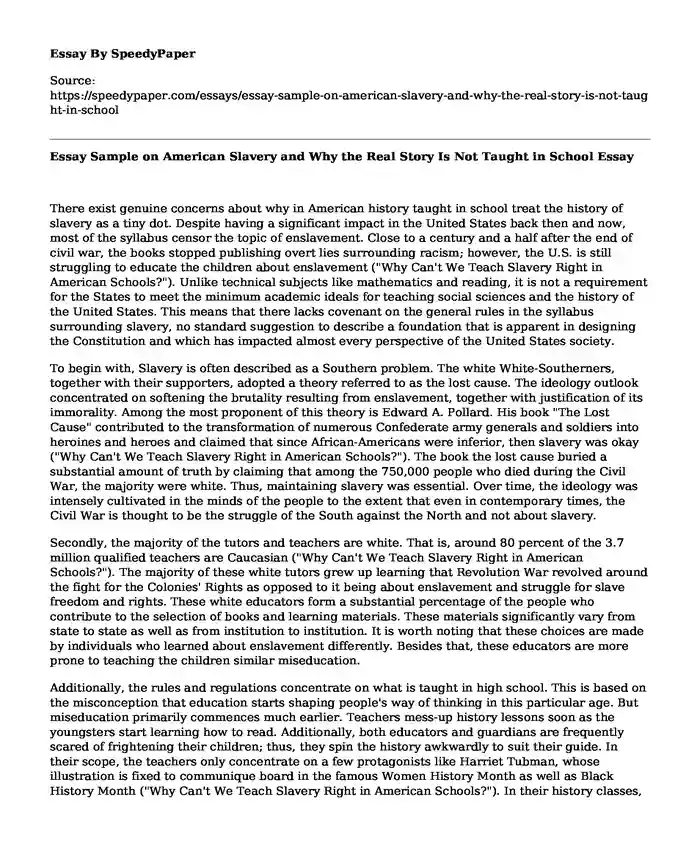There exist genuine concerns about why in American history taught in school treat the history of slavery as a tiny dot. Despite having a significant impact in the United States back then and now, most of the syllabus censor the topic of enslavement. Close to a century and a half after the end of civil war, the books stopped publishing overt lies surrounding racism; however, the U.S. is still struggling to educate the children about enslavement ("Why Can't We Teach Slavery Right in American Schools?"). Unlike technical subjects like mathematics and reading, it is not a requirement for the States to meet the minimum academic ideals for teaching social sciences and the history of the United States. This means that there lacks covenant on the general rules in the syllabus surrounding slavery, no standard suggestion to describe a foundation that is apparent in designing the Constitution and which has impacted almost every perspective of the United States society.
To begin with, Slavery is often described as a Southern problem. The white White-Southerners, together with their supporters, adopted a theory referred to as the lost cause. The ideology outlook concentrated on softening the brutality resulting from enslavement, together with justification of its immorality. Among the most proponent of this theory is Edward A. Pollard. His book "The Lost Cause" contributed to the transformation of numerous Confederate army generals and soldiers into heroines and heroes and claimed that since African-Americans were inferior, then slavery was okay ("Why Can't We Teach Slavery Right in American Schools?"). The book the lost cause buried a substantial amount of truth by claiming that among the 750,000 people who died during the Civil War, the majority were white. Thus, maintaining slavery was essential. Over time, the ideology was intensely cultivated in the minds of the people to the extent that even in contemporary times, the Civil War is thought to be the struggle of the South against the North and not about slavery.
Secondly, the majority of the tutors and teachers are white. That is, around 80 percent of the 3.7 million qualified teachers are Caucasian ("Why Can't We Teach Slavery Right in American Schools?"). The majority of these white tutors grew up learning that Revolution War revolved around the fight for the Colonies' Rights as opposed to it being about enslavement and struggle for slave freedom and rights. These white educators form a substantial percentage of the people who contribute to the selection of books and learning materials. These materials significantly vary from state to state as well as from institution to institution. It is worth noting that these choices are made by individuals who learned about enslavement differently. Besides that, these educators are more prone to teaching the children similar miseducation.
Additionally, the rules and regulations concentrate on what is taught in high school. This is based on the misconception that education starts shaping people's way of thinking in this particular age. But miseducation primarily commences much earlier. Teachers mess-up history lessons soon as the youngsters start learning how to read. Additionally, both educators and guardians are frequently scared of frightening their children; thus, they spin the history awkwardly to suit their guide. In their scope, the teachers only concentrate on a few protagonists like Harriet Tubman, whose illustration is fixed to communique board in the famous Women History Month as well as Black History Month ("Why Can't We Teach Slavery Right in American Schools?"). In their history classes, these youngsters mostly learn about the United States Founders but rarely read about the implications of slavery and that many of the nation's founders owned slavery.
To show this miseducation, an associate professor of history in Ohio states university describes an incident where his child describes "Fun Facts" facts about George Washington. The child only expresses his love for rabbits and how he owned and tended to them, completely sidelining the fact that he held people as slaves too. The daughter only describes how George Washington did not have teeth while ignoring the fact that his dentist used slave teeth as a replacement. Thomas A. Bailey, in his book, "The American Pageant" was influenced by the school of thought known as the Dunning School ("Why Can't We Teach Slavery Right in American Schools?"). The theory is the African-Americans were generally incapable of self-governance, thus justifying the fact of the Whites owning, and controlling and enslaving the blacks. These skewed lines of thought and teaching have a more significant impact on the high-schoolers. A survey of at least more than half of the schoolers reported that in the classroom, there was infrequency is a proven practice of good learning regarding history.
Work Cited
"Why Can't We Teach Slavery Right in American Schools?" The New York Times, 19 Aug. 2019, www.nytimes.com/interactive/2019/08/19/magazine/slavery-american-schools.html?referringSource=articleShare.
Cite this page
Essay Sample on American Slavery and Why the Real Story Is Not Taught in School. (2023, Apr 01). Retrieved from https://speedypaper.com/essays/essay-sample-on-american-slavery-and-why-the-real-story-is-not-taught-in-school
Request Removal
If you are the original author of this essay and no longer wish to have it published on the SpeedyPaper website, please click below to request its removal:
- The Aging Nurses' Workforce in Nevis: Strategies for Retention, Article Analysis Sample
- Paradox in Metaphysics: The Ship of Theseus, Free Essay in Philosophy
- Free Essay with the Case Study on Biomedical Ethics in the Christian Narrative
- Health Disparity Essay Sample: Diabetes amongst Latino Population in the United States
- Essay Sample: The Epic of The Odyssey
- Essay Example on Cars Should Not Be Banned From the City Centers
- The Story Is Set In Bosnia and the USA. Paper Example
Popular categories





